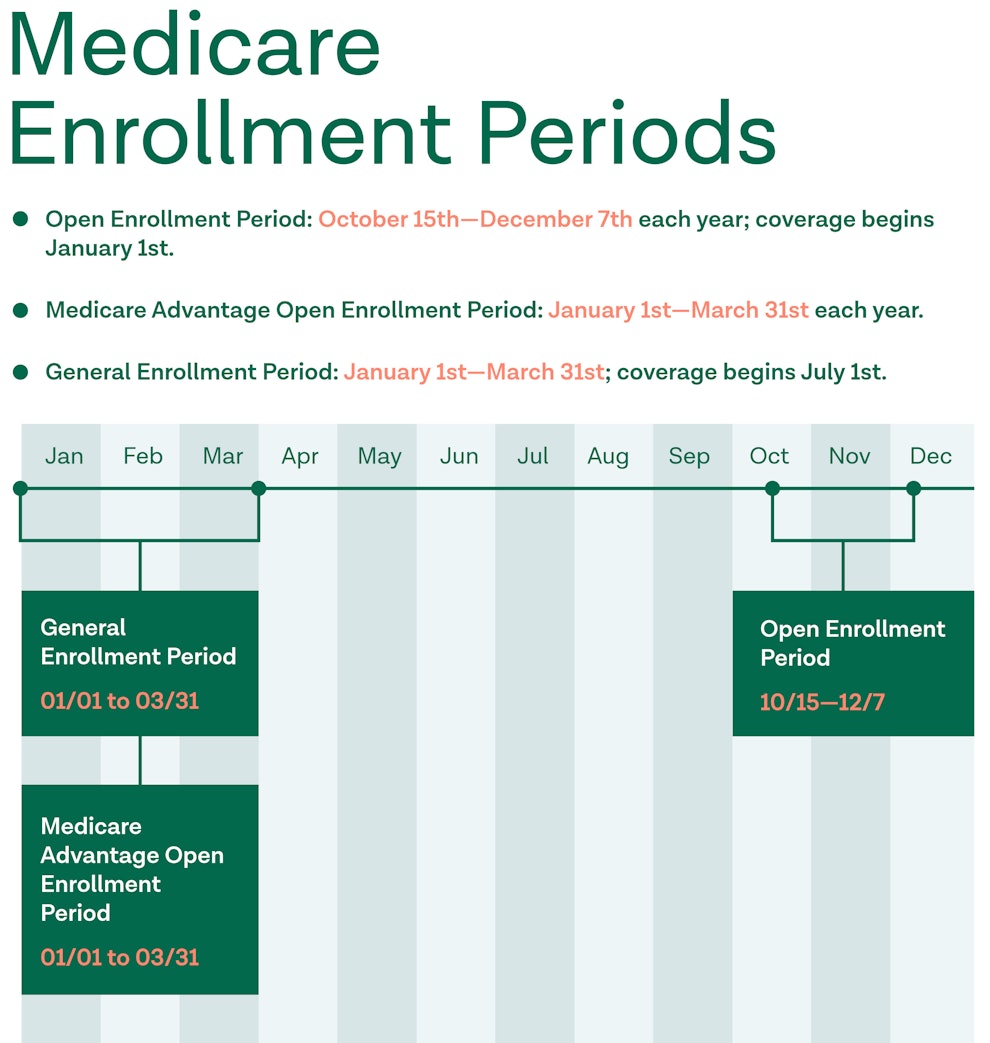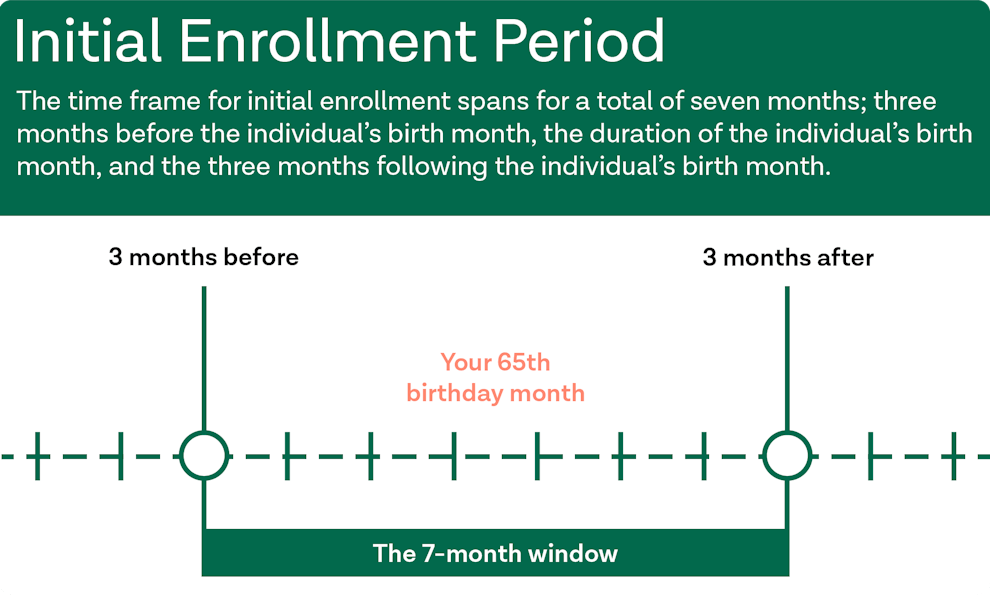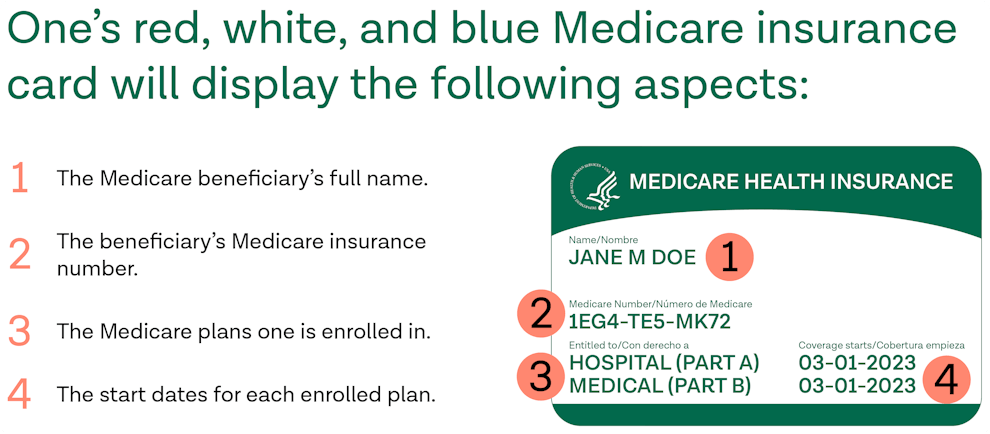When is Medicare Open Enrollment: Dates, Eligibility, & More
Article at a glance
The Federal Medicare Program has a wide variety of enrollment periods, with open enrollment being one of the most common. During open enrollment, beneficiaries are able to reevaluate their coverage and decide to join, switch, or drop a specific plan.
Along with open enrollment, Medicare also has their initial enrollment period, general enrollment period, and more. Each of these enrollment periods have unique timeframes and purposes.
Medicare eligibility encompasses a wide range of individuals including those 65 and older, younger than 65, spouses, and more. However, it’s important to note that there are specific qualifications each group has in order for the enrollee to be eligible for Medicare.
Cost is a big factor when selecting insurance plans. Learn more below about the projected 2022 plan costs prior to changing or switching policies during open enrollment.

When is Medicare Open Enrollment?
Medicare is the health insurance program for those 65 and older funded by the United States Federal Government. The Medicare open enrollment period begins annually on October 15th and lasts until December 7th. This period of time permits Medicare or Medicare Advantage (MA) enrollees to reevaluate their coverage and decide to join, switch, or drop a specific plan. If enrollees get their choices in by the December 7th deadline, their new coverage begins on January 1st.
The Medicare Advantage open enrollment period begins on January 1st and lasts until March 31st. During this time frame, MA enrollees are able to change from one Medicare Advantage plan to a different Medicare Advantage plan or switch to a standard Medicare plan. It’s important to note that Medicare and Medicare Advantage enrollees are able to participate in plan changes during standard Medicare open enrollment, however, only MA enrollees may participate in plan changes during the MA open enrollment period.
What Can Be Done During Open Enrollment
Throughout Medicare open enrollment, enrollees have the option to do the following:
As long as the enrollee is already enrolled in both Medicare Parts A and B, they can switch from Original Medicare to an MA plan.
Switch from an MA plan to a standard Medicare plan with the option to add Medicare Part D as well.
Switch one’s Medicare Advantage plan type (HMO to PPO, PPO to PFFS, etc.)
Switch one’s Medicare Part D prescription plan.
Enroll in Medicare part D if one did not do so during the initial enrollment period.
What Can’t Be Done During Open Enrollment
During Medicare open enrollment, there are few options that may not be available to enrollees, such as:
Enroll in Medicare Part B.
Enroll in a Medigap (MedSupp) plan.
If an individual is looking to enroll in either of these plans and did not do so during their initial enrollment period, they are able to enroll during Medicare’s general enrollment period. The general enrollment period for Medicare runs from January 1st to March 31st with coverage beginning on July 1st.

Other Medicare Enrollment Periods
When it comes to Medicare, there are a few different enrollment periods throughout the year that enrollees should be aware of, such as:
Initial Enrollment Period
One’s initial enrollment period is when an individual first becomes eligible to enroll in Medicare. The time frame for initial enrollment spans for a total of seven months; three months before the individual’s birth month, the duration of the individual’s birth month, and the three months following the individual’s birth month. During this time, new enrollees are able to join Medicare Part A, B, and/or D, enroll in a Medicare Advantage plan, enroll in a dual eligibles plan (Medicaid-Medicare), or add on a Medigap (MedSupp) plan to their standard Medicare coverage. It’s important to note that if patients wait to enroll in Part B during their initial enrollment, payment penalties may incur in the future.
Special Enrollment Period (SEP)
Some enrollees are eligible to extend their initial enrollment period into what is called a “Special Enrollment Period.” If a patient undergoes a life change that causes them to lose their coverage, they can be eligible to enroll in Medicare later on with the SEP. The special circumstances required for eligibility are vast and to learn more about what they entail, visit this source.
General Enrollment Period (GEP)
If individuals miss their chance to enroll in Medicare Part B or to add a Medigap plan to their standard Medicare policy, they are able to do so during the GEP. Medicare’s general enrollment runs from January 1st to March 31st with coverage beginning on July 1st.

Medicare Eligibility
Medicare eligibility incorporates a wide variety of individuals including those 65 and older, those younger than 65, and spouses of enrollees.
65 & Older: When an individual turns 65, they may become eligible to enroll in Medicare. If they have been working and paying Medicare taxes for at least ten years, then they are eligible for premium-free Part A coverage. Individuals who are United States citizens but have not paid for Medicare taxes are still eligible to purchase Part A coverage.
Under 65: In particular circumstances, those under the age of 65 are eligible for and able to get Medicare insurance. These circumstances include those already receiving Railroad Retirement Board benefits, receiving Social Security disability benefits, those with Lou Gehrig’s disease (ALS), and those with permanent kidney failure (ESRD) who regularly receive dialysis treatments.
Spouses: Non-working individuals are also eligible for Medicare if their spouse (of at least one continuous year) has worked for ten years and paid Medicare taxes. In addition, divorcees that were married for at least ten years and are currently single may also qualify for Medicare under their ex-spouse’s work record.
Note: To learn more about Medicare eligibility, visit this source.

How to Enroll in Medicare
The majority of patients may automatically be enrolled in Medicare three months prior to the month they turn 65. However, other patients in select circumstances (those who haven’t worked and paid Medicare taxes for ten years, those under the age of 65, etc.) may have to apply for Medicare coverage. After a patient has been enrolled, either automatically or through an application, they will receive a “Welcome to Medicare” package in addition to their Medicare insurance card. This package will include guides and other information to assist the new enrollee with enrollment and using their new Medicare insurance.
Prior to selecting or switching any Medicare plans during open enrollment, enrollees should carefully reflect on their health care needs and evaluate the options made available to them. Look over the “Medicare & You 2022” handbook to learn the most up-to-date coverage information or log on to an online account to read information that’s personalized to your current plan. Online, enrollees are also able to preview the 2022 Part D prescription drug plans or MA plans. Lastly, if an enrollee desires information that’s particular to their state or area, they can speak with a representative at the State Health Insurance Assistance Program (SHIP).
Note: To learn more about enrolling in Medicare, visit this source or this source.

Projected Costs of Enrollment
When it comes to Medicare, there are a few different costs to consider depending on which plan an individual enrolls in.
Part A Projected Costs
Medicare Part A is considered to be Medicare’s “hospital insurance” as it covers all necessary inpatient care. The projected costs for Medicare Part A in 2022 are as follows:
Part A Premium: Most individuals who have worked for ten years and paid Medicare taxes will receive Part A coverage premium-free. However, for those who have worked for anywhere between 7.5 and 9 years while paying Medicare taxes, Part A can be purchased for $274 per month. For those who have worked for less than 7.5 years and paid for Medicare taxes, they may purchase Part A coverage for $499 per month.
Part A Deductible: The projected Part A deductible is $1,556 per benefit period, not per year. Up to 60 days in the hospital are covered.
Part A Coinsurance: For days 61–90 in the benefit period, the coinsurance will be $389 per inpatient day. For days 91 and on in the benefit period, the coinsurance will be $778 per inpatient day.
Part B Projected Costs
Medicare Part B is considered to be Medicare’s “medical insurance” as it covers all necessary outpatient care. The projected costs for Medicare Part B are as follows:
Part B Premium: The projected premium for Part B in 2022 is $158.50 per month, however, high-income enrollees may pay a higher premium price.
Part B Deductible: The projected deductible for Part B is $217 in 2022. The enrollee must pay this deductible before Medicare begins to pick up 80% of the cost of care.
Part B Coinsurance: Once the deductible is paid, the patient is responsible for 20% of the cost of care with Medicare covering 80%.
Part C Project Costs (Medicare Advantage)
Medicare Advantage is considered to be a supplemental form of coverage for Medicare as it typically fills the gaps in coverage for things like prescription drugs, dental care, vision services, and more. The projected costs for Medicare Advantage plans are as follows:
MA Premium: The projected premium for MA plans is the Part B deductible of $158.50 per month plus an additional $19 a month.
MA Maximum Out-of-Pocket: The out-of-pocket maximum for MA plans is $7,550, not including prescription drug costs.
Part D Projected Costs
Medicare Part D is known as Medicare’s optional prescription drug plan coverage. The projected costs for Medicare prescription drug coverage (Part D) in 2022 are as follows:
Part D Premium: The average Part D premium is projected to be $38 a month. However, there are a wide range of Part D plans available, leaving premiums to range from as low as $7 a month to $100 a month so it’s important to evaluate which plans are best for you.
Part D Deductible: The maximum deductible is projected to be $480 in 2022, however, some plans require no deductible at all.
Note: To learn more about the 2022 projected costs of Medicare, supplemental plans like Medigap (MedSupp), and the Medicare income-related monthly adjustment amount (IRMAA), visit this source.

What Comes After Enrollment
After an enrollee makes a change to their Medicare policy, they should receive a letter from their new Medicare plan that walks them through any pertinent information. A new insurance card will also be provided to them via mail so they can see their providers or refill prescriptions without delay.

Other Medicare Options to Consider
With Medicare overseeing a large population of people, there are a lot of coverage options to ensure each individual is cared for in a way that’s best for them. Other Medicare supplement insurance options include:
Medigap (MedSupp)
Medicare allows for supplemental coverage plans, like Medigap, to be added in order for patients to fill any gaps in coverage. To learn more about adding a Medigap plan to your standard Medicare, visit this source.
Medicare Advantage Prescription Drug (MAPD) Plans
Another common supplemental plan that enrollees select is a Medicare Advantage Prescription Drug (MAPD) plan. This plan allows enrollees to intertwine prescription drug coverage into their MA plan. To learn more about enrolling in an MAPD plan, visit this source.
Dual Eligibles
If an enrollee is eligible for both Medicare and Medicaid, they are allowed to link the programs for supplemental coverage. In this case, Medicare would act as the primary insurance plan with Medicaid acting as the supplemental plan. To learn more about enrolling in a dual eligibles plan, visit this source.
MA Give Back Benefit
Some Medicare Advantage plans offer what is called a “give back benefit” where the Part B premium is reduced. To learn more about the Part B Premium Reduction Plan or the “give back benefit,” visit this source.
Sources
- https://www.medicare.gov/sign-up-change-plans/joining-a-health-or-drug-plan
- https://www.medicare.gov/blog/medicare-advantage-open-enrollment
- https://www.medicareresources.org/medicare-open-enrollment/
- https://www.medicare.gov/sign-up-change-plans/when-can-i-join-a-health-or-drug-plan/special-circumstances-special-enrollment-periods
- https://www.medicare.gov/blog/medicare-enrollment-period-2020
- https://www.medicare.gov/account/login/
- https://www.medicare.gov/Pubs/pdf/10050-Medicare-and-You.pdf
- https://www.medicare.gov/plan-compare/#/?lang=en&year=2022
- https://www.shiphelp.org/
- https://www.medicare.gov/blog/get-ready-medicares-open-enrollment-starts-october-15
- https://www.medicareresources.org/glossary/benefit-period/
- https://www.medicare.gov/drug-coverage-part‑d/how-to-get-prescription-drug-coverage/how-to-switch-your-medicare-drug-plan
- https://www.cms.gov/Outreach-and-Education/Medicare-Learning-Network-MLN/MLNProducts/downloads/medicare_beneficiaries_dual_eligibles_at_a_glance.pdf
- https://www.medicare.gov/supplements-other-insurance/whats-medicare-supplement-insurance-medigap
- https://www.medicarefaq.com/faqs/medicare-part-b-give-back-plan/
- https://www.cms.gov/newsroom/press-releases/cms-releases-2022-premiums-and-cost-sharing-information-medicare-advantage-and-prescription-drug
Become a patient
Experience the Oak Street Health difference, and see what it’s like to be treated by a care team who are experts at caring for older adults.



